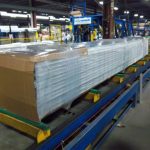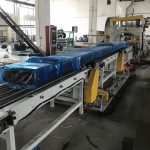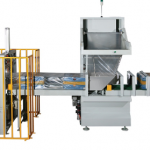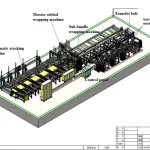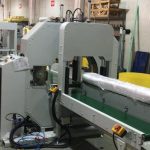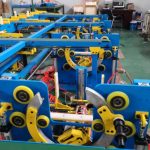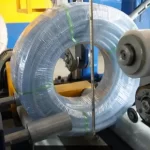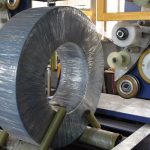Good Packaging Solutions for Aluminum Profiles: Wrapping Machine Combined with Shrinking Machine
In the manufacturing and logistics industries, effective packaging is pivotal for maintaining product integrity, reducing damage during transit, and enhancing overall efficiency. When it comes to aluminum profiles, choosing the right packaging solution is essential. This article explores the benefits of using a wrapping machine combined with a shrinking machine as an effective packaging method for aluminum profiles. We will analyze the components, advantages, operational processes, and best practices to ensure optimal packaging solutions.
Understanding Aluminum Profiles
What Are Aluminum Profiles?
Aluminum profiles are extruded sections of aluminum that are used in various applications, including construction, automotive, and manufacturing. They are lightweight, corrosion-resistant, and versatile, making them ideal for a range of structural applications. However, their delicate nature means they require careful packaging to prevent scratches, dents, and other forms of damage during storage and transit.
Importance of Proper Packaging
Proper packaging is crucial for aluminum profiles due to the following reasons:
- Protection: Packaging safeguards aluminum profiles from physical damage and environmental factors such as moisture and dust.
- Brand Image: Well-packaged products enhance a company’s image, reflecting professionalism and attention to detail.
- Cost Efficiency: Effective packaging reduces the risk of damage, minimizing the costs associated with returns and replacements.
- Compliance: Certain industries have regulations regarding packaging and transportation, making compliance essential.
The Role of Packaging Machinery
What is a Wrapping Machine?
A wrapping machine is designed to apply a protective layer around products, usually using plastic film. This process is critical for securing items and preventing damage during handling and transit.
What is a Shrinking Machine?
A shrinking machine uses heat to shrink the packaging film tightly around the product, creating a secure and protective seal. This process is often used in conjunction with wrapping machines to provide an additional layer of protection.
Benefits of Using a Combined Wrapping and Shrinking Machine
1. Enhanced Protection
Combining a wrapping machine with a shrinking machine offers superior protection for aluminum profiles. The wrapping machine provides an initial layer of protection against scratches and impacts, while the shrinking machine ensures a tight fit, preventing movement during transit.
2. Improved Efficiency
Using integrated packaging solutions streamlines the packaging process. Instead of managing separate machines, operators can handle a unified system, reducing labor costs and minimizing the time spent on packaging.
3. Cost Savings
Efficient packaging reduces material waste and minimizes the number of damaged products, leading to significant cost savings over time. The initial investment in a wrapping and shrinking machine can be offset by the reduction in returns and replacements.
4. Customization Options
Modern wrapping and shrinking machines often come with customizable settings, allowing businesses to adjust the packaging process according to the specific dimensions and requirements of their aluminum profiles.
5. Increased Throughput
By automating the packaging process, businesses can increase their throughput, meeting higher production demands without compromising quality.
How the Combined Process Works
Step 1: Wrapping
The first step involves the wrapping machine applying a protective film around the aluminum profiles. This film can be polyethene or PVC, depending on the desired level of protection. The wrapping process typically includes:
- Feeding: Aluminum profiles are fed into the wrapping machine.
- Wrapping: The machine wraps the film around the profile, ensuring complete coverage.
- Sealing: The ends of the film are sealed to secure the wrap.
Step 2: Shrinking
Once the profiles are wrapped, they move to the shrinking machine. The process involves:
- Heating: The wrapped profiles are passed through a heating chamber where hot air is circulated.
- Shrinking: The heat causes the film to shrink, conforming tightly to the shape of the aluminum profiles.
- Cooling: After shrinking, the profiles are cooled, solidifying the protective layer.
Choosing the Right Machines
1. Assess Your Production Needs
Before purchasing a wrapping and shrinking machine, assess your production volume and the types of aluminum profiles you handle. Higher volumes may necessitate more robust machines with faster throughput capabilities.
2. Consider Film Types
Different types of films offer varying levels of protection. Choose a film that is compatible with both the wrapping and shrinking machines and provides the necessary durability for your products.
3. Evaluate Machine Features
Look for machines equipped with features such as adjustable speeds, customizable wrapping patterns, and easy-to-use controls. Advanced features can enhance operational efficiency and allow for better adaptation to changing production needs.
4. Maintenance and Support
Evaluate the maintenance requirements of the machines you are considering. Reliable customer support and easy access to replacement parts are crucial to minimize downtime.
Best Practices for Packaging Aluminum Profiles
1. Quality Control
Implement a rigorous quality control process to ensure that every aluminum profile is wrapped and shrunk correctly. Regularly inspect the machinery and the final product to identify any issues early.
2. Employee Training
Ensure that all employees are trained in the operation of wrapping and shrinking machines. Proper training enhances safety and efficiency, reducing the likelihood of errors.
3. Regular Maintenance
Establish a maintenance schedule for your wrapping and shrinking machines. Regular servicing prevents breakdowns and extends the lifespan of the equipment.
4. Optimize Packaging Design
Design packaging that minimizes waste while providing maximum protection. Customizing the size of the wrapping film to fit the specific dimensions of your aluminum profiles reduces excess material and ensures a snug fit.
5. Monitor Environmental Conditions
Keep an eye on the environmental conditions in your storage and packaging areas. Extreme temperatures or humidity can affect the integrity of the packaging materials and the aluminum profiles themselves.
Environmental Considerations
Reducing Packaging Waste
As sustainability becomes increasingly important, consider using recyclable or biodegradable materials for your wrapping and shrinking processes. This not only helps the environment but also appeals to environmentally conscious consumers.
Energy Efficiency
Choose machines that are designed for energy efficiency. Modern wrapping and shrinking machines often use less energy while providing the same level of performance as older models.

Case Studies: Successful Implementation
Case Study 1: Aluminum Manufacturing Plant
An aluminum manufacturing plant implemented a combined wrapping and shrinking machine to enhance its packaging process. The result was a 40% reduction in packaging time and a 25% decrease in product damage during transit. The plant reported significant cost savings, allowing them to invest in further automation.
Case Study 2: Construction Supply Company
A construction supply company faced challenges with the packaging of aluminum profiles, resulting in high return rates due to damage. By integrating a wrapping and shrinking machine, they achieved consistent packaging quality, which improved customer satisfaction and reduced return costs by 30%.
Future Trends in Packaging Solutions
Automation and Smart Technology
The future of packaging solutions is likely to include more automation and smart technology. Machines equipped with IoT capabilities can provide real-time data on packaging processes, allowing for better monitoring and optimization.
Custom Packaging Solutions
As industries evolve, the demand for customized packaging solutions will increase. Businesses may look for machines that can adapt to various product shapes and sizes, offering more flexibility in packaging.
Sustainability Initiatives
With growing environmental concerns, the packaging industry will continue to focus on sustainable practices. Innovations in biodegradable films and energy-efficient machines will likely become more prominent.
Conclusion
Implementing a wrapping machine combined with a shrinking machine offers an effective solution for packaging aluminum profiles. This integrated approach enhances protection, improves efficiency, and reduces costs, making it a wise investment for businesses in the manufacturing and logistics sectors. As you consider your packaging options, focus on your specific production needs, film types, and machine features. By adopting best practices and staying aware of industry trends, you can ensure that your packaging solutions remain effective and sustainable. Ultimately, choosing the right packaging machinery will not only protect your aluminum profiles but also contribute to your company’s overall success and reputation in the market.
